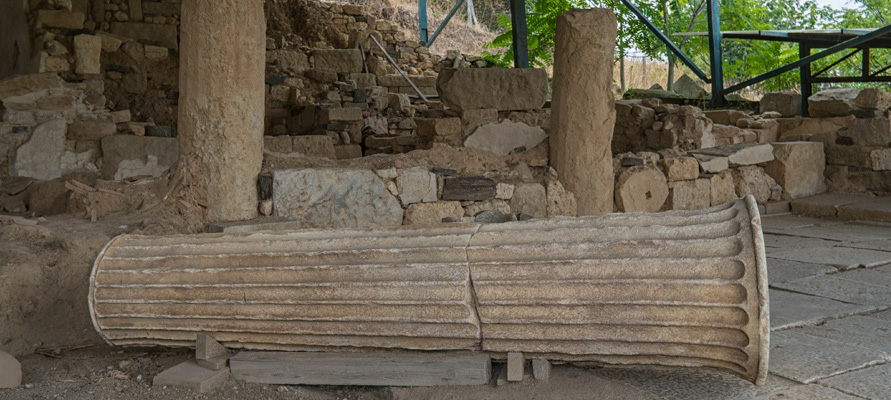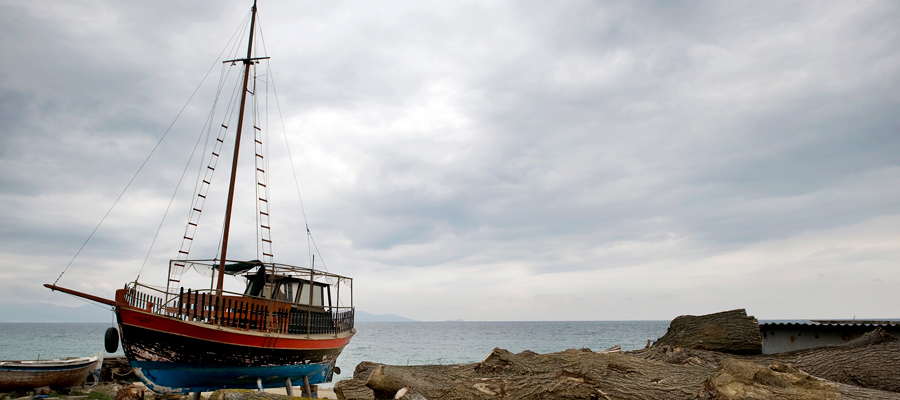
3D Theater
The Cultural Centre hosts the first in Greece 3D theatre which showsstereoscopic videos since 2004. The Centre hosts, also, an exhibition halland a congress hall.

The tower of Krouna
The tower of Krouna
https://clair-studios.gr/the-tower-of-krouna/ 2/2
One of the most important sights in the region of Ierissos is the tower ofKrouna, located approximately 1km northwest of the town. It was adependency, surrounded by a wall, which has almost collapsed. It isestimated that it was built in the 15th century and it is named after thealteration of the word “Koroni”, since sources of 1320 mention the Skala ofKoroni north of the area, near the port of Kleisouri. Furthermore, theproperty is mentioned as a dependency of Korouna in Ottoman documentsof the 15th century and belonged to the Hilandariou monastery until 1542.Then, the monastery periodically lost ownership of the dependency until1719, when it was purchased among other properties in the area. It wassold and repurchased at least twice.
In 1765, it was recorded as “destroyed dependency Korona of theHilandariou monastery”. Some attempts of repairing it took place until 1821,when the tower was burnt and the dependency was abandoned. Otherbuildings such as a house, a barn and stables also existed outside thetower. During the 19th century, the dependency still belonged in theproperties of the Hilandariou monastery. Nowadays, the tower is 12m inheight. It is said that it had an additional floor that collapsed. Many sourcesrefer to it with its full name, Tower of Krouna of Hilandariou monastery. Themonument belongs to the jurisdiction of the 10th

Akanthos
Akanthos (Ancient Greek: Ἄκανθος; Latin: Acanthus) was an ancientGreek city on the Athos peninsula. It was located near the modern town ofIerissos on the north-east side of Akti, on the most eastern peninsula ofChalcidice. Strabo and Ptolemy erroneously place Acanthus on the SingiticGulf, but there can be no doubt that the town was on theStrymonian Gulf,as is stated by Herodotus and other authorities: the error may have perhapsarisen from the territory of Acanthus having stretched as far as the SingiticGulf. The name of the ancient city (derived from the acanthus bush) is dueto the thorny nature of the area or to the thorny nature of the town’sfoundation.
History
Foundation
It was founded by 7th century BC (the archaeology suggests 655 BC) bycolonists from Andros, according to Thucydides. Plutarch, on the otherhand, referred to it as a mixed colony of Andrians and local Chalcidians,which was founded on the “Coast of Drakontos”, in place of a preexistingcivilization. He writes that settlers from Andros and Chalcisarrived on theshore at the same time. The natives of Acanthus, seeing the crowd ofsettlers, became frightened and left the city. The settlers sent an explorereach to see what had happened and, as they approached the city andrealized it was empty, ran to be the first to take over the land for their fellowcountrymen. The Chalcidian was the fastest but the Andrian, seeing he waslosing, stopped and threw his spear on the wall’s gate, before his opponentarrived. A court case followed, which was won by the Andrians, because asthey protested, they had just about taken over the city first.
Growth
Its growth during the Archaic period is reflected by the wide circulation of itscurrency, first minted around 530 BCE with the distinctive emblem of a lionkilling a bull – perhaps linked to Herodotus’s account (vii. 125) that on themarch of Xerxes from Acanthus to Therma, lions seized the camels whichcarried the provisions – at least 92 different types of coins have been found.Its economic resources emanated from the mining and wood from thenearby forests, but also through agricultural and vegetable goods that weretransported through the sizable harbor.
The first historical reference, in Thuycidides, from mid-5th century BC,connects the city with the Persian Wars, during which the townsfolk officiallywelcomed the Persians and willingly helped with the digging of the canal forXerxes, 480 BC, for which Xerxes richly rewarded them. They declared oneof his relatives who died in the area, named Artahei, a hero, and willinglytook part in the expedition against Greece. After the Persian wars Acanthusbecame a member of the Athenian Alliance, paying tribute of three talents.In 424 BCE, after a short siege and oratory by Brasidas, the city wasconvinced to ally itself with the Spartans, although Thucydides remarks thegreater likelihood that it was the threat to destroy their profitable vineyards,rather than Brasidas’s rhetoric, that truly moved the Acanthians.
Situation
4th to 2nd centuries BCE
In the initial phase of the establishment of the Chalcidice League, it wasmainly smaller towns and cities in Macedonia that were enrolled. Only whenit was firmly established was an offer made to Acanthus. When this was a second offer was made but with the threat that force would beused should Acanthus refuse to join the federation. The townsfolk refusedto join it, in part due to the old quarrel with the Chalcidians. Under threatfrom the Chalcidians, Acanthus called in Sparta’s help, which came in 382BC when the Spartans and Acanthians captured and destroyed Olynthosand the alliance, at least temporarily. Acanthus’s staying-out of the alliancemeant that in 350 BC, when it was conquered by Philip II of Macedon, itwas not destroyed. Later it was incorporated to the region of Ouranoupolis,a new city that was founded by Alexarchos (Cassander’s brother), in theisthmus, between the Strymoinan and the Singitic gulfs.
According to Livy, Acanthus was attacked by a Roman-Pergamene fleet in199 BC during the Second Macedonian War and then besieged, capturedand sacked by Rome in 168 BC.
Roman period
The Romans later exploited all the natural sources of wealth and its harbor,and the town continued through the Roman and Byzantine period. InRoman times is attested epigraphically the existence of a Romancommunity attracted mainly by the rich mines of this region Around thestart of the 1st century, Acanthus’s renaming began, with its nametranslated into the Latin Ericius , from which was derived its Byzantine andmodern name of Ierissos or Erissos.
Description
The ancient city extended along a sheer hillside, about 0.6 km (2,000 ft)south-east of modern Ierissos. Remains of walls, an impressive citadel, andHellenistic buildings survive, along with a deserted Byzantine church andtwo post Byzantine churches.
Necropolis
The city itself has not been excavated, but the necropolis (graveyard) has,starting in 1973, since when more than 600 graves have been discovered.Particularly extensive is the sight of the cemetery along the seaside of Ierissos.
The graveyard seems to have been used for a long period, starting from theArchaic period (or perhaps even the 17th century BCE) right up to Romantimes and later, perhaps with certain intervals in between each period oftime. The graves occur in at least two or three layers, either shallow in theearth, or deeper in the sand, usually parallel with the line of the seashore. The orientation of the dead (that is, skulls of the dead – and the tops ofjugs) is, in most cases, southeast.
In Acanthus both adults and children were buried in the same areaaccording to ancient burial customs. Various grave types have beendiscovered – some are simple dirt holes, others coated with clay orundecorated or painted clay urns, yet others are shaped like boxes,covered in clay or jug-shaped (jug-shaped most probably constituted themajority of infant or child burials). The grave goods, usually placed in thegraves next to or above the dead, are varied and sometimes in earthencontainers. Often they were personal or related to their occupation (such asjewels, pins, buckles, mirrors, weapons – though these are rare -, needles,hooks, bill-hooks, knives or – very often in female and child graves – clay figurines representing various animals, foodstuffs, or human forms, such asactors). Some of the goods are locally made whilst some are from othercommercial centres and workshops of the ancient world. Burial customs,and similar types of graves which have been discovered, resemble manyother cemeteries in other ancient cities of Macedonia and Thrace, revealingthe connection through trade to so much of the Greek-speaking East aswell as to other well-known centres of the Peloponnessus (especiallyEuboea, Athens, Corinth and Boeotia).

Karnagio
Impressive is the area of the yard, which have retained as much of the oldcharacter. Enchanting is the spectacle of shipyards, where old hulls of shipsas Biblical “arks” and opened their big eyes you will “travel” in fairy seasons.And though the new pipeline, freshly painted and kalafatismena will giveyou the impression that the span of time is endless.
The shipyard is a very famous attraction and attracts many tourists everyyear. There is in this place for centuries, and a main occupation of theinhabitants was fishing and the sea in general.
The inhabitants of Ierissos described as great shipwrights, a profession thatpasses from generation to generation. The boats are made of pine wood inthe same traditional way they were made centuries ago.
Today there are three shipyards and making manufactured here, travelingthe seas of all Greece, unique ambassadors of incomparable art ofIerissioton shipwrights. Master of traditional shipbuilding considered thePapasterianos p. Dimitrios, who is not currently in life.

Cultural Center of Ierissos
It is housed in an impressive building in the center of Ierissos, since 2004. Itwas approved by the European Investment Bank as a center for thepromotion of the Athonite heritage and the promotion of the Mount Athosarea with the use of modern technology. The first successful attempt of thecenter’s partners was the creation of a high-resolution video titledTravelogue in Mount Athos. In 2010, other movies were also filmed such asthe SeaWorld and the Aesop’s Fables. It has a modern amphitheater with acurved screen 50sq.m. in size and 4 projectors for the projection of 3Dmovies (that viewers watch wearing special glasses), as well as anexhibition hall.
The exhibition hall this period hosts the photo exhibition “Mount Athos: 1000years in 100 photos”.
Info
For information call: +30 23770 21130 or visit the website 3D Theatre.
